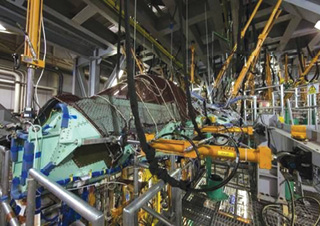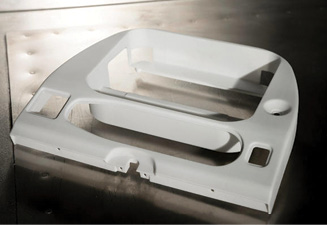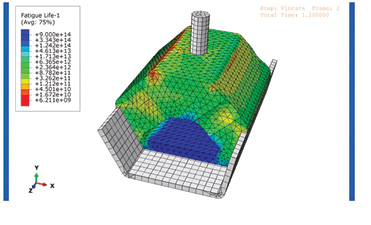Advanced Materials Challenge Durability Testing

Materials used in the F-35 fighter jet are subjected to continuous testing on long-term durability; results data are sent daily to engineers. Image courtesy of nCode (HBM Prenscia).
Latest News
October 1, 2018
Basic materials have radically transformed in recent years, as advances in chemistry and physics offer lighter yet stronger, resistant yet breathable, and many other feature combinations once thought impossible. A variety of resins, polymers, fibers and composite materials make materials specification an adventure in possibilities. A biomechanical engineer can design a new knee, but it takes a biomaterials engineer to find the right materials that can replace bone and cartilage. A computer scientist can design circuits for a high-speed CPU, but a materials engineer creates the semiconductor base.
Spending on research into advanced materials is increasing, according to Stewart Bland, Ph.D., of Materials Today. Research papers published on the subject increased 140% between 2004 and 2014. A recent survey from ASM International on materials-related technologies identified several materials categories “expected to have significant impact” in the near future, including new materials for high performance, energy and additive manufacturing.
Materials are the final frontier in the rollout of digital engineering processes. Factors like weight and color are trivial compared to the need to deeply understand durability—and to translate it into digital data. Basic and applied materials scientists are tasked with creating mind-boggling new materials and formulating testing processes that simultaneously prove suitability and provide the data to bring materials into the digital engineering chain. The increased use of 3D printers for final production is also creating new demands for materials data. Manufacturers need to validate new materials in simulations. Durability testing providers have become the gatekeepers in this process of bringing materials into the product design and development process.
Fatigue Challenges
Many manufacturers use test results provided by materials vendors, but certain disciplines, including aerospace and defense, must conduct their own rigorous testing. BAE Systems is a lead contractor for the F-35 fighter jet, also known as the joint combat aircraft (JCA). It operates a specific Structural and Dynamic Test Facility (S&DT) in Brough, UK, to create quantitative data to prove airframes meet their structural design specifications over the operational lifetime. The S&DT team has created a complex test rig with more than 3,800 data acquisition channels, managed by various nCode software products and related equipment from HBM Prenscia. The system conducts static and fatigue tests. A typical test routine generating gigabytes of data is delivered to engineers in the UK and North America in less than two hours.
nCode software is also used in the Turbocharger Research Institute at the University of Huddersfield, UK. “We find their expertise in fatigue and durability is particularly useful as turbochargers present engineers with many complex fatigue challenges,” says John Allport, institute director. “Aluminium impeller durability is driven by high-speed centrifugal forces; creep is an issue for aluminium compressor housings, and thermomechanical fatigue is an issue for turbine housings.”
New Materials for 3D Printing
The 3D printing industry is moving from being a source for prototypes to a source for part production. Prototyping materials are generally not engineered for real-world use, so the challenge is to create specialized, durable materials suitable for final production. “In many instances, choosing production-grade materials is more cost effective than only serving prototyping needs,” says Scott Cost, director of SLS product management at 3D Systems. “Parts last longer without failing and that durability over time saves money and effort.”
 3D Systems’ SLS production-grade nylon material DuraForm FR1200 is FAR 25.853 compliant, the flame retardant standard for aerospace. Image courtesy of 3D Systems.
3D Systems’ SLS production-grade nylon material DuraForm FR1200 is FAR 25.853 compliant, the flame retardant standard for aerospace. Image courtesy of 3D Systems.End-use production parts have different requirements from jigs and fixtures, so 3D Systems has engineered a variety of production-grade SLS materials to suit the broader market. “End-use interior parts need to have flexibility, durability and impact resistance while assembly jigs and fixtures need strength and rigidity,” notes Cost. “We have spent the last two years developing new materials designed to satisfy our customers’ demands for elongation, flexibility, impact strength, rigidity, temperature resistance or flame retardancy.”
The first two production-grade select laser sintering (SLS) materials released by 3D Systems were an aluminum-filled nylon and a true black production-grade nylon 11 material, which requires minimal post-processing (no coatings). The company recently certified—in cooperation with Emirates Airlines—an SLS nylon that meets FAR 25.853 aerospace standards for interior flame retardancy, has a UL rating for consumer good use and carries Form 1 certification for aircraft use. The certification process took almost 12 months.
At the International Manufacturing Technology Show in Chicago last month, Stratasys showed off its Fortus 380mc Carbon Fiber Edition, an industrial system available for $70,000. The material used in the 3D printer, Stratasys Nylon 12CF, is 35% chopped carbon fiber by weight. The company says it has the highest stiffness-to-weight ratio of any filament 3D-printed part.
“In addition to tools and jigs, customers are using it for end-use connectors and brackets, replacing aluminum in many case” says Stratasys Senior VP of Sales Pat Carey.
Making Predictions
Predicting noise, vibration and harshness (NVH) fatigue is a key element of product engineering today. Endurica has emerged as a recognized vendor in the durability simulation software market. The competition is not other software vendors but traditional “build and break” testing methods, says William Mars, Endurica president. “Build and break is a plan for business failure. The advent of simulation has fueled a new ‘right the first time’ movement that empowers the engineer to very rapidly investigate and understand how alternative materials, alternative geometries or alternative duty cycles impact durability.”
The Endurica CL solver for finite element analysis (FEA) uses rubber fracture mechanics principles and critical plane analysis to calculate fatigue lifetimes for every element in a simulation model. The resulting data gives engineers a clear view of the complete lifetime of a product or material without time-consuming and expensive physical prototypes.
The combination of new materials and market pressures is pushing research into advancing the state of durability testing. The University of Manitoba (UM) has conducted several studies they refer to as “test tailoring,” in which specific materials are matched with specific CAE processes. The goal is to reduce the time of conventional durability testing without altering failure mechanisms.
In one test, UM researchers matched an aluminum alloy to the design of a cantilever beam and tested it in a simulation written in ANSYS Parametric Design Language. The simulation could do random vibration analysis and harmonic response analysis, but was not written to do unit acceleration displacements and strains while performing harmonic analysis. So the research team achieved acceleration displacement through “coupled degrees of freedom” to excite the base. The results were then passed to nCode’s DesignLife solver, which could complete the test problem. The team concluded “good agreements have been found between the numerical results from the computer-aided model and the experimental results.”
 Endurica specializes in FEA of elastomers, compressing test cycles and eliminating the production of physical prototypes for every design iteration. Image courtesy of Endurica.
Endurica specializes in FEA of elastomers, compressing test cycles and eliminating the production of physical prototypes for every design iteration. Image courtesy of Endurica.Subscribe to our FREE magazine, FREE email newsletters or both!
Latest News
About the Author
Randall S. Newton is principal analyst at Consilia Vektor, covering engineering technology. He has been part of the computer graphics industry in a variety of roles since 1985.
Follow DE





